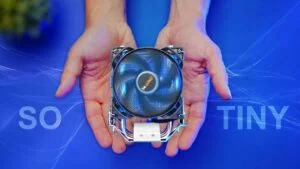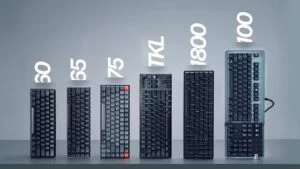Omen 30L – A Ryzen Gaming PC TEARDOWN

Share:
This article is a bit of a different one for us. We are going to take a look at the pre-built Omen 30L gaming PC, which is pretty unique in a number of ways. First of all, Omen is going all in on AMD with the 30L series by offering a variety of Ryzen CPUs and higher-end Radeon and GeForce graphics cards. Therefore, buyers who simply want a plug and play system can take advantage of all the goodness that Ryzen has to offer.
I have to thank both Omen and AMD since they are sponsoring this video, and they basically told us to go nuts on this PC. They told us to do whatever we want with it, so we are basically going to take this whole thing apart, examine the components piece by piece, and then find out if there are any areas for improvement. This is going to be exciting.
Omen claim that they have designed the 30L with an eye towards super easy upgrades, by avoiding the custom components that large system builders sometimes use. However, how close is that to the truth? Well let’s just say that the 30L is essentially a blend of lessons that Omen has learned from the DIY market, but they have also added a few more things that I would love to see in my next build too.
Price & Options
For those of you who are interested, the 30L has a ton of configuration options. They go from a Ryzen 5 3600 and an RX 5700 XT all the way up to a Ryzen 9 3900, RTX 2080 Ti gaming, 32GB of DDR4-3200 memory, and tons of storage. Our sample is a middle of the road spec with a Ryzen 9 3900, RTX 2080 Super, 16 GB of DDR4-3200 memory, a 256GB SSD and a 1TB hard drive. The Ryzen 9 3900 is a seriously rare gem of a CPU since you can’t buy at retail, but more on that a little bit later.
Design
The 30L uses a stealth matte black theme that is pulled off really, really well on the inside and outside. By the way, yes that 30L model name means it’s 30 liters in size. There are some clear points taken from the DIY case market here with a good 2 inches of ventilation on either side of the front panel for airflow to the front 120mm fan and a controllable RGB illumination. Personally, I also like the I/O’s positioning at the top, since its recessed notch leads to easier access and less height restrictions. One of the things I wanted to bring up right away is you will see a lot of additions to the system that are engineered to protect the components and their connections in case the FedEx delivery person decides to kick the package around a bit… which happens.
Internals
Let’s see what is under the hood, and to do that you will need to hit the rear-mounted “internal access” button and the side panel pops open. Pretty simple. There is a locking mechanism running the opening’s entire length that uses metal latches to hold everything securely in place. It’s really well executed, and I wish more cases had this. Not only that, but an easy access set up like this will give novices more confidence to get in there and upgrade components or even troubleshoot them. The first thing I noticed is how well integrated the RGB lighting strip is, it’s tucked away into the cases upper area and there is a reflector to make sure there is even light spill within the interior space.
Speaking of access, cable management is pretty well done, the fan headers are at the top edge, and the clear CMOS jumper is clearly visible as well. While the NVMe SSD’s position means only two memory modules can be installed, getting to it doesn’t require moving anything else or shifting cables around. There are two plastic 3.5-inch hard drive caddies along the 30L’s front, and they have completely tool-less installation. In our case, a 1TB 7200 RPM Seagate drive was pre-installed, but Omen also pre-wired the second spot just in case a user wanted to easily add more storage, which is a nice touch. Installation of a hard drive is pretty straightforward too, just slide out the caddy, pop out the vibration dampening mounts onto the drive, locking it place and slide it back in. There is space on the caddies for a 2.5-inch drives too, but Omen doesn’t provide the necessary mounting screws.
Fans & Airflow
Now let’s discuss airflow, and even though there is plenty of ventilation the lower front 120mm fan is the only one that can be installed since the rest of this area lacks any cutouts or mounting points. That is too bad, and there is also no dust filter there. That second fan is actually sourced from Cooler Master, and while we can’t find it anywhere in their current lineup, it looks like a high airflow OEM version of their MasterFan Balance series with an additional LED halo ring attached to it.
That front-mounted fan mostly pushes air towards the GPU’s intake area and then onwards to the power supply, which has a side mounted fan to take advantage of be natural right to left airflow in this section. A bit of that fresh air is also being funneled upwards towards the CPU area, and then exhausted with a rear 80mm fan. You probably haven’t seen an 80mm exhaust fan in a while, but Omen wanted to keep the chassis as narrow as possible so adding a larger fan wasn’t possible. Omen also provides a top mounted 120mm fan bracket if you want to install one there, but while the holes are there the airflow certainly isn’t. There is just a blank metal plate there, so I wouldn’t advise bothering with that.
Graphics Card
With that out of the way, let’s start taking this thing apart, starting with the RTX 2080 Super. It is held in place with a plastic brace that is supposed to protect it during shipping, but it also acts as a convenient anti-sag bracket. The card itself is pretty unique too. This is a reference card engineered specifically for system integrators, so instead of having a downdraft like the RTX 2080 Super Founder’s Edition it uses a blower style set up with a really awesome looking design. Now I know what you are thinking, usually blower-style cards run louder, hotter, and because of that extra heat are typically slower than downdraft designs. Let’s test out that theory below.
As you can see, after 50 minutes of full load in a closed system both cards run at very similar clock speeds. As a matter of fact, they were nearly identical over the entire test. Moving over to temperatures, the Founders Edition was slightly lower, but that didn’t seem to affect performance in any meaningful way. It seems like NVIDIA’s boost algorithm is working perfectly well here. With that said the RTX 2080 Super in this system was a bit louder than the Founders Edition, but it also gave lower interior case temperatures. There is a bit of a trade off, but not as much as I thought there would be. A lot of this card’s ability to properly cool the GPU without getting overly loud comes from its massive copper heatsink and a vapor chamber design. You should also know that the boards design is the same one used on the Founder’s Edition with an 8+2 phase VRM layout.
Wi-Fi Module & More
As we kept disassembling the system there are two really interesting things that we noticed. The first is the brilliant way Omen is handling the Wi-Fi on the system. A lot of motherboards use these antennas that are designed to isolate the wireless signal from interference, but they are a royal pain in the butt to find a place for. In this case the antenna arrays start at the M.2 module and they run behind the motherboard tray and then split and end on either side of the front panel’s Omen logo. While most of the antenna is behind metal, which would technically reduce EMI and signal strength, the last 3 inches are broadcasting through that clear tempered glass panel. I love it.
The other cool little addition is the secondary SATA powered controller board, which houses all of the necessary functions for RGB lighting in Omen’s Control Center. That means you can install a different motherboard, hook it up to this board, and then still use the built-in app. The Control Center is actually one of the cleanest and most straightforward pieces of software I have seen in a while. In it you can control fan speeds, different RGB zones, and a whole lot more, so having the option to use it with a new motherboard is pretty nice.
Performance
The next stop on our little tour is the Ryzen 9 3900 processor, which is the real star of the show since you can’t actually go out and buy this thing. Nope, it’s distributed directly to AMD’s system partners so they can incorporate a high-end processor without worrying about excess heat and power consumption. AMD has engineered the 3900 in a pretty straightforward way. It’s a lower power 65W version of the 3900X, which features the same 12-cores/24 threads layout, but it runs at lower cock speeds to keep the TDP in check. But what are you giving up over 3900X? Well, it turns out not that much. I mean the 65W chip’s performance is a bit slower, but there are still 24 threads chewing away and that means super fast runs productivity apps. Even in gaming the RTX 2080 Super’s performance nullifies much of the 3900X’s advantage. Basically, you are getting 90% of the performance from a processor that has a 40W lower TDP.
The Motherboard
Now that lower wattage processor allowed Omen to use a pretty basic B450 mATX motherboard for the 30L. It actually has one of the first true matte black PCBs I have ever seen, and I think it looks great. There is a single PCI x16 slot without any other add-in card options, space for two memory modules, and the one M.2 slot that allows for full length SSDs. The other M.2 slot is populated with a Wi-Fi module and it uses Key-E so forget about replacing it with an SSD. It’s a bit too bad Omen didn’t use all the space between the CPU cooler and the primary GPU slot for another M.2 drive though. While three of the fan headers are used, the one reserved for a liquid cooling pump can have another fan installed.
Around the back there is a standard I/O layout on the USB front, but this board is missing the necessary audio outputs for multi-channel speaker setups. Meanwhile, the 4-pin CPU power connector, 4-layer PCB, and limited chipset cooling means there is no official support for overclocking, but Ryzen Master can actually be used to increase clock speeds. I wouldn’t suggest doing that though, since the CPU cooler and other components aren’t built to handle higher power… plus you void the warranty. Now under full system load for about 30 minutes, the VRMs on the board stayed relatively cool, even though there aren’t any heatsinks installed. This is probably because part of the cooler’s airflow goes directly over them on its way to the exhaust fan.
Cooling
Speaking of the air cooler, it’s designed by Cooler Master and mounted to the motherboards backplane with four Torx bolts. It’s topped with a clear RGB LED fan, but the heatsink portion looks a lot like a slightly better version of AMD’s Wraith Stealth cooler. You can really tell that this is made to cool off a 65W processor and nothing more, especially since the base doesn’t make full contact with the Ryzen CPU’s integrated heatspreader. However, does it work well enough? Well at normal fan speeds setting in Omen’s Command Center the temperature never got above 84°C and clock speed stayed pretty stable within AMD specs too. Needless to say that you would get much lower temperatures and noise by switching this thing out for something like a Cooler Master Hyper 212 Black Edition.
Memory & Power Supply
As for the memory, Omen is using a HyperX Fury RGB DDR4-3200 CL16 kit, and these seem to be the only ones whose RGB lighting can be controlled through the built-in app. Meanwhile, other modules I have – which aren’t Omen certified – defaulted to DDR4-2400, and there is no way to manually set speeds in Ryzen Master, the BIOS, or any other piece of software. It looks like Omen has optimized their systems for their own validated memory modules. I hope that this changes in the future because it does limit memory upgrades. The 500W 80 Plus Silver rated power supply also comes from Cooler Master, and there are a few unique things about this too. It has flat black cables that blend in perfectly with the 30L’s interior design, and unlike a lot of other DIY PSU’s it uses a single rear mounted exhaust fan instead of a large 120mm or 140mm intake. Unfortunately, it doesn’t actually have an on/off switch, so if you need to unplug it, if a power cycle is needed, or if the system needs to be completely turned off during extended periods of time, you are out of luck.
Conclusion
Obviously we did put the system back together after the teardown process, and as you can see it works. While we don’t cover a lot of pre-built desktop systems on the channel, taking it apart the Omen 30L showed how much these systems are evolving to offer more of what gamers are looking for in a plug and play form factor. It’s obvious that Omen did take some inspirations from the DIY market about implementing better components and also offering users easier upgrade options as well. Not to mention the design is definitely different from pre-built desktop systems from generations ago, and I hope that that trend continues. The 30L isn’t necessarily perfect, and for enthusiasts like you and me these things will never replace the joy of building your own PC, but I’m excited to see what the next generation of pre-built gaming PCs that are going to look like. That shouldn’t take long because the new AMD Ryzen CPUs are right around the corner – which is exciting – and that will mean new systems for us to take a look at.
Check out more Omen PC products at the HP Store in the links below:
Omen 30L Gaming PC – https://bit.ly/2Y4hW1b
27i Gaming Monitor – https://bit.ly/3441ody
Mindframe Headset – https://bit.ly/3asXbRP
Sequencer Keyboard – https://bit.ly/3kOubsM
Omen PC products at Best Buy:
27i Gaming Monitor: https://bit.ly/2E30wLx
Mindframe Headset: https://bit.ly/3kSbULc
Sequencer Keyboard: https://bit.ly/3fY06Dq



















































































